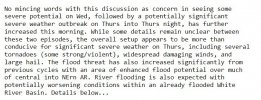CheeselandSkies
Member
12Z NAM and GFS are doing some...weird things with this system. Both certainly still show potential for some dangerous storms to evolve, but this is the range at which you'd like to see models come into better consistency and agreement and that is not happening.
Honestly, being a professional meteorologist these days would drive me to drink (only thing worse than trying to forecast severe weather is trying to forecast winter precipitation). So many sources of information and all of it pointing in different directions.
Honestly, being a professional meteorologist these days would drive me to drink (only thing worse than trying to forecast severe weather is trying to forecast winter precipitation). So many sources of information and all of it pointing in different directions.


